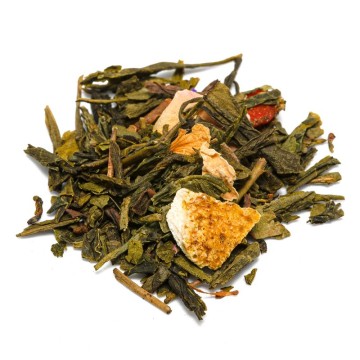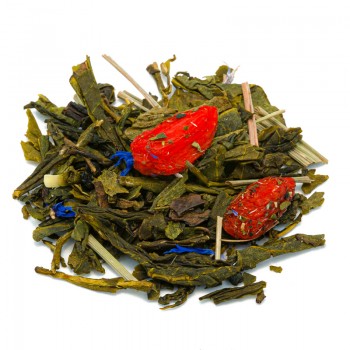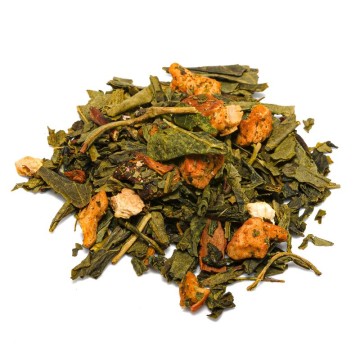Strawberry and pineapple green tea: properties and benefits
This unique and aromatic blend is made up of Sencha green tea, a part of fine Pai Mu Tan white tea, and delicious ingredients for the fruity taste . Mango flakes, pineapple flakes, orange wedges, freeze-dried strawberry slices. All enhanced with a touch of calendula petals, to give even more sweetness and a delicate flavour. It is a perfect tea in winter, when it exudes the aromas of fruit, and in the hot season when drunk cold – for a refreshing taste that revives the senses.
The basis of this infusion is Japanese Sencha, a green tea with thin leaves that gives a naturally sweet flavor thanks to the processing of the leaves. Its texture is enhanced by the delicate notes of strawberry, pineapple and other fruits, in order to obtain a light and fruity tea, full of beneficial compounds. The green tea mix uses Sencha because it goes perfectly with the sweet taste of the fruit. The aromatic and juicy strawberry, in the flavor joins the soft tea for a refreshing effect and a slightly astringent finish, also thanks to the pineapple. The fruit within this infusion renders the benefits of the high concentration of antioxidants, vitamins and minerals in this fruit. Strawberries can increase the calcium intake in the body, and enhance the contribution of minerals and vitamins of green tea.
This drink helps to speed up the metabolism, promoting weight loss, thanks to the catechins contained in green tea. Together with theine (caffeine) and other antioxidants, catechins can improve calorie burning – combining green tea with a proper diet. Burning more calories improves metabolism, and you can also use this tea to decrease feelings of hunger.
It works by promoting slimming, also thanks to the diuretic properties of Sencha and pineapple, which increase the drainage of excess liquids. The elements of this tea act as a natural diuretic, promoting the elimination of fluids and toxins retained in the body and counteracting swelling. Among the health benefits of Strawberry Pineapple Green Tea, are the many antioxidants and nutrients that help the body functions, such as manganese and potassium. The powerful antioxidants of these elements (green tea, strawberry, pineapple), act against free radicals, reducing inflammation in the body. In addition, the vitamin C contained in strawberries and green tea is an anti-aging factor, and this infusion tones the skin and helps the immune system.
Origins and History of cultivation
Sencha is a type of green tea, born from leaves that undergo a treatment with steam. It is very popular in Japan, but is also grown in other countries. Originally, the plant grew wild in China, Tibet and Northern India. Green tea was brought to Japan from China, and the processing methods were also inspired by Chinese ones. To date, the Sencha processing method has been perfected in Japan, and each green tea is unique due to some differences in cultivation and processing.
It can be classified according to the time of harvest, also identified according to the region in which it was grown, the particular cultivation, and the treatment with steam. The particular processing is traced back to the tea farmer known as Nagatani Soen. It was he who invented a method to stop the oxidation of the leaves through steaming, pressing and rolling.
Since then, the tea leaves subjected to this process have been called Sencha. Like most green teas, sencha is grown in the sun and the leaves are hand-picked at various times throughout the season. In this way we obtain Sencha from the first harvest, the most valuable, the Sencha from the second harvest and so on. The more the leaves ripen, the less the quality is considered high.
However, the active principles of green tea are always present. Once harvested, the leaves are subjected to steam cooking, in some cases longer than the normal procedure. In this way, the leaves break down into small filaments, ensuring a faster infusion. The strawberry is a fruit known for thousands of years, especially in the wild with wild strawberries. They were called "fruits of the heart" due to their shape and colour, dedicated to the goddess Venus in antiquity.
In Europe, strawberry plants were cultivated only after the Renaissance period, and their success increased with the cultivation in France during the eighteenth century, at the court of Louis XIV. Also in this century they arrivedor various non-European species of strawberries, such as the white strawberry plants in Chile. The crossbreeding with wild American species gave rise to the well-known "large" strawberry (compared to wild strawberries), the Fragaria Ananassa that we consume today. The pineapple plant is native to Brazil and Paraguay, as well as some areas of South America. Known to local populations for centuries, pineapple was already consumed in 3000 BC. according to some archaeological evidence; it was cultivated by the Mayans and the Aztecs. It was later imported into Europe by European colonizers, and was very successful among noble and wealthy families. Over time, pineapple cultivation has spread to many tropical countries including the Philippines, now one of the largest pineapple exporters.
Plant and flowers
Tea leaves derive from the Camellia Sinensis plant (also called Thea sinensis) which is part of the Theaceae family. It is an evergreen tree native to East Asia, and the genus includes about 250 species of trees and shrubs. Only 3 are usually used: Chinese, Assamic and Cambodian. In the production of tea, the shrubs are grown in reduced dimensions, although they can reach about 9 meters in height. The small bushes make it easier to harvest the leaves by hand, which takes place several times a season. Tea plants are pruned often, to 60 or 90 cm., to encourage the development of new leaves and shoots.
The flowers are fragrant, yellow and about 4 cm wide, while the fruit has a hard green shell and a single seed. Strawberry is a fruit of the plant genus Fragaria, which includes over 20 species of flowering plants in the Rosaceae family. The cultivated varieties are spread throughout the world, as they are low-growing herbaceous plants. They show fibrous roots, a large crown and leaves composed of three leaflets with serrated margins. The flowers are usually white, rarely reddish.
The fruit of the strawberry is considered an accessory fruit and not a true berry. Because the pulp is made up of the receptacle of the enlarged flower, formed by the numerous real fruits, or achenes, commonly called seeds. The Ananas comosus plant is part of the Bromeliaceae family. As a fruit plant, it is not very tall, and grows on rich, well-drained soil with an acid pH. It is born in the tropical climate, since it prefers exposure to full sun and warm temperatures.
Pineapples grow slowly, and can take up to about 2 years to reach full maturity. The purple, pink or red flowers give the fruits known for their shape, which resembles a pine cone. The pineapple we eat is actually made up of flowers and berries of the plant that come together to form a single fruit. As the fruit ripens, offshoots emerge from below and a new one from the top. Each of these branches can be split, to yield a new pineapple.
Nutritional values of Strawberry and pineapple green tea
Green tea contains several antioxidant polyphenols, including EGCG (Epigallocatechin gallate). It makes methylxanthines (caffeine, theobromine, theophylline), vitamin C and group B vitamins (thiamine, riboflavin, niacin) bioavailable. Pineapple is a source of beneficial substances such as iodine, vitamin C, organic acids and bromelain. It also makes minerals such as potassium, calcium, iron and manganese available. The strawberry also provides vitamin C, potassium, iron, manganese and phosphorus.
How to prepare strawberry and pineapple green tea
The infusion is obtained by placing about 3-5 grams of the green tea with strawberry and pineapple mixture in a cup (250 ml), with water at 80 °C. Let it steep for 2 to 3 minutes before drinking this green tea. Add honey or sugar, if desired.
Strawberry and pineapple green tea: side effects and contraindications
If consumed in excess, this tea can have some unwanted side effects, including gastrointestinal discomfort, cramps, constipation, nausea. Strawberry and pineapple green tea, if taken in large quantities can also cause annoying symptoms, in terms of stimulation of the nervous system. Dizziness, anxiety, insomnia, tremors, heart palpitations, and blood pressure changes may occur. Caution is advised for any known allergies in the ingredients of the infusion, and for pregnant and breastfeeding women.









 No reward points for this product.
No reward points for this product.










![Ginseng and ginger green tea [Natura d'Oriente]](https://www.naturadoriente.com/3367-home_default/Green-tea-ginseng-ginger.jpg)




![green tea hemp mango [Natura d'Oriente]](https://www.naturadoriente.com/3381-home_default/green-tea-mango.jpg)